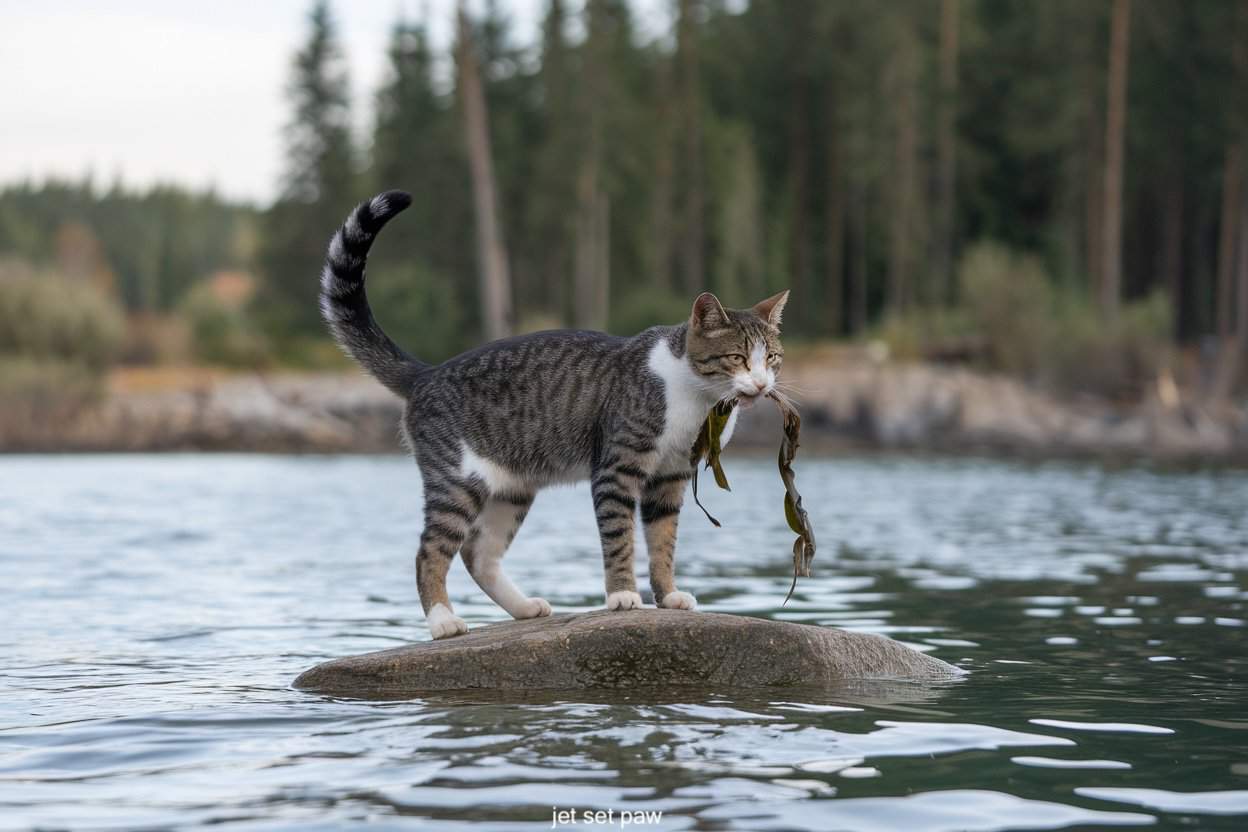Seaweed is a plant that grows in oceans and other bodies of water. It comes in many different shapes, sizes, and colors.
People eat seaweed in various forms, like the wraps around sushi rolls or as a healthy snack. Seaweed is known for being nutritious and containing many vitamins and minerals.
Many cat owners are curious about what foods are safe for their feline friends. As seaweed becomes more prevalent in human diets, people naturally wonder if it’s okay for cats to eat it, too.
Some might have seen their cats show interest in seaweed snacks or noticed seaweed listed as an ingredient in cat food.
This curiosity leads to the vital question: Can cats eat seaweed? This blog post will explore how to help cat owners make informed decisions about their pets’ diets.
Types of Seaweed
People eat many types of seaweed. Some of the most common ones include nori, which is used to wrap sushi, and wakame, often found in miso soup.
Kelp is another popular seaweed that’s used in various dishes and supplements. Dulse is a red seaweed that some people enjoy as a salty snack. These seaweeds are safe for human consumption and are packed with nutrients.
When it comes to cats, you might be surprised to learn that some cat food brands already use seaweed as an ingredient.
They often add small amounts of kelp or other seaweeds to their recipes. This is because seaweed can provide extra vitamins and minerals for cats.
However, the amount of seaweed in these products is usually tiny and carefully measured to be safe for cats.
It’s important to remember that seaweed in cat food differs from the seaweed humans eat, as it’s specially prepared for feline diets.
Benefits of Seaweed for Cats
Seaweed can offer some nutritional benefits for cats when given in small amounts. It’s rich in minerals like iodine, vital for thyroid health.
Seaweed also contains vitamins A, B, C, and E, which can support a cat’s overall health. Some types of seaweed are high in protein and fiber, which can suit a cat’s diet when provided in the right amounts.
There are potential health advantages to including small amounts of seaweed in a cat’s diet. The iodine in seaweed may help maintain a healthy thyroid, essential for a cat’s metabolism.
The antioxidants found in seaweed could help boost a cat’s immune system. Some cat owners report that seaweed supplements have improved their cats’ coat health, making it shinier and softer.
However, it’s important to note that while these benefits exist, they haven’t been extensively studied in cats, and more research is needed to understand how seaweed affects feline healthfully.
Risks and Concerns
While seaweed can have some benefits, there are risks to consider when feeding it to cats. One main concern is digestive issues.
Cats have sensitive stomachs, and introducing too much seaweed or too quickly can cause upset stomachs, vomiting, or diarrhea. This is especially true if the cat isn’t used to eating seaweed or other plant-based foods.
Another substantial risk is the salt content in seaweed. Most seaweeds naturally contain a lot of salt, which can harm cats if eaten in large amounts.
Too much salt can lead to dehydration and even sodium poisoning in severe cases. Cats don’t need much salt in their diets, so it’s crucial to be careful with salty foods like seaweed.
Lastly, seaweed, especially dried seaweed snacks meant for humans, can be a potential choking hazard. When wet, these can expand, which could cause problems if a cat swallows large pieces whole.
The texture of some seaweeds might also be difficult for cats to chew properly, increasing the risk of choking. It’s always better to be safe and avoid giving cats large pieces of seaweed or letting them eat it unsupervised.
How to Safely Introduce Seaweed to Cats
If you want to introduce seaweed to your cat’s diet, it’s essential to do it safely. The best forms of seaweed for cats are those specifically made for pets.
You can find seaweed supplements designed for cats in many pet stores. These are safer than human seaweed snacks because they’re made with cats in mind.
Some cat foods also contain small amounts of seaweed, which can be a good way to include it in your cat’s diet.
When it comes to serving sizes, less is more. Start with small amounts, like a tiny pinch of seaweed powder mixed into your cat’s regular food.
This should be done no more than once or twice a week. If you’re using a seaweed supplement for cats, follow the instructions on the package carefully.
Remember, seaweed should never replace your cat’s diet but should only be given as an occasional treat or supplement.
It’s crucial to watch for signs that your cat might be allergic or intolerant to seaweed. Look out for symptoms like vomiting, diarrhea, excessive scratching, or changes in behavior after eating seaweed.
Stop giving your cat seaweed and talk to your vet if you notice these signs. Some cats might also dislike the taste or smell of seaweed, and that’s okay, too. Never force your cat to eat something they don’t want.
Alternatives to Seaweed for Cats
There are several options if you’re looking for alternatives to seaweed that are safe and nutritious for cats.
Cooked lean meats like chicken or turkey can provide protein and other nutrients. Small amounts of cooked fish, like salmon or tuna, can offer omega-3 fatty acids suitable for your cat’s skin and coat.
Some vegetables, like cooked pumpkin or sweet potato, can be given in small amounts for fiber and vitamins. Always introduce new foods slowly and in small quantities to avoid upsetting your cat’s stomach.
Many commercial cat treats offer similar benefits to seaweed. Look for treats that are specially formulated to support your cat’s health.
Some treats contain added vitamins and minerals, while others might focus on supporting dental health or helping with hairballs.
You can find treats with ingredients like fish oil for skin and coat health or probiotics for digestive health. These treats are often safer than giving human foods because they’re made specifically for cats.
Always choose treats made by reputable pet food companies and follow the feeding instructions on the package.
Conclusion
To sum up, seaweed can offer some benefits for cats, like providing essential minerals and vitamins. It might help with thyroid health and could improve a cat’s coat.
However, there are also risks to consider. Seaweed can cause digestive problems, contains a lot of salt that might lead to dehydration, and could be a choking hazard.
If you decide to give your cat seaweed, it’s important to introduce it safely, use forms made for pets, and provide tiny amounts.
When feeding seaweed to cats, it’s best to be cautious. While some cats might benefit from small amounts of seaweed as a supplement, it’s unnecessary for their diet.
Many cats can get all the nutrients they need from balanced cat food. If you’re considering adding seaweed to your cat’s diet, it’s a good idea to talk to your veterinarian first.
They can help you decide if it’s right for your cat and guide you on how to do it safely. Remember, every cat is different, and what works for one might not work for another.
The most important thing is to prioritize your cat’s health and well-being in whatever decisions you make about their diet.

